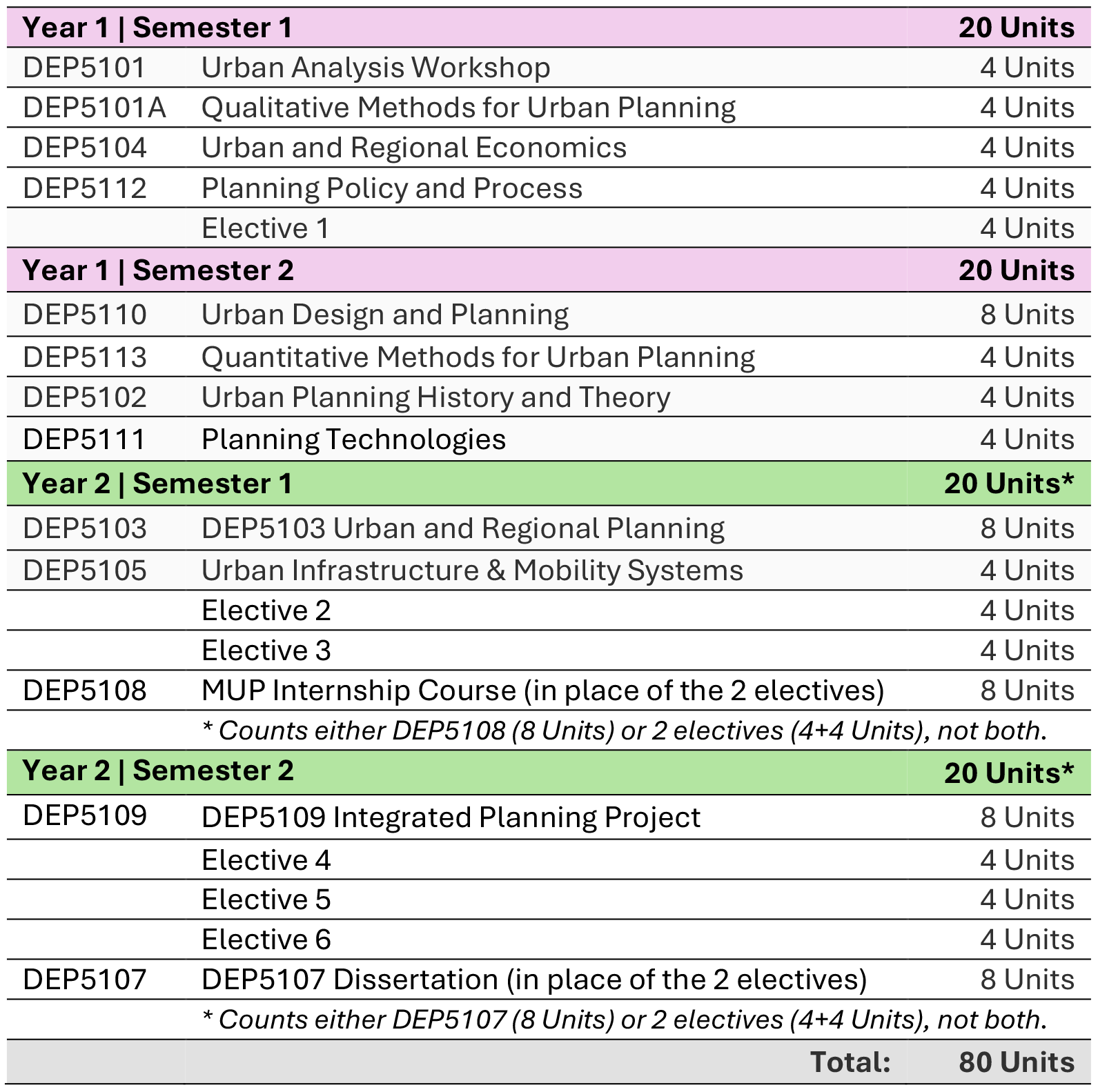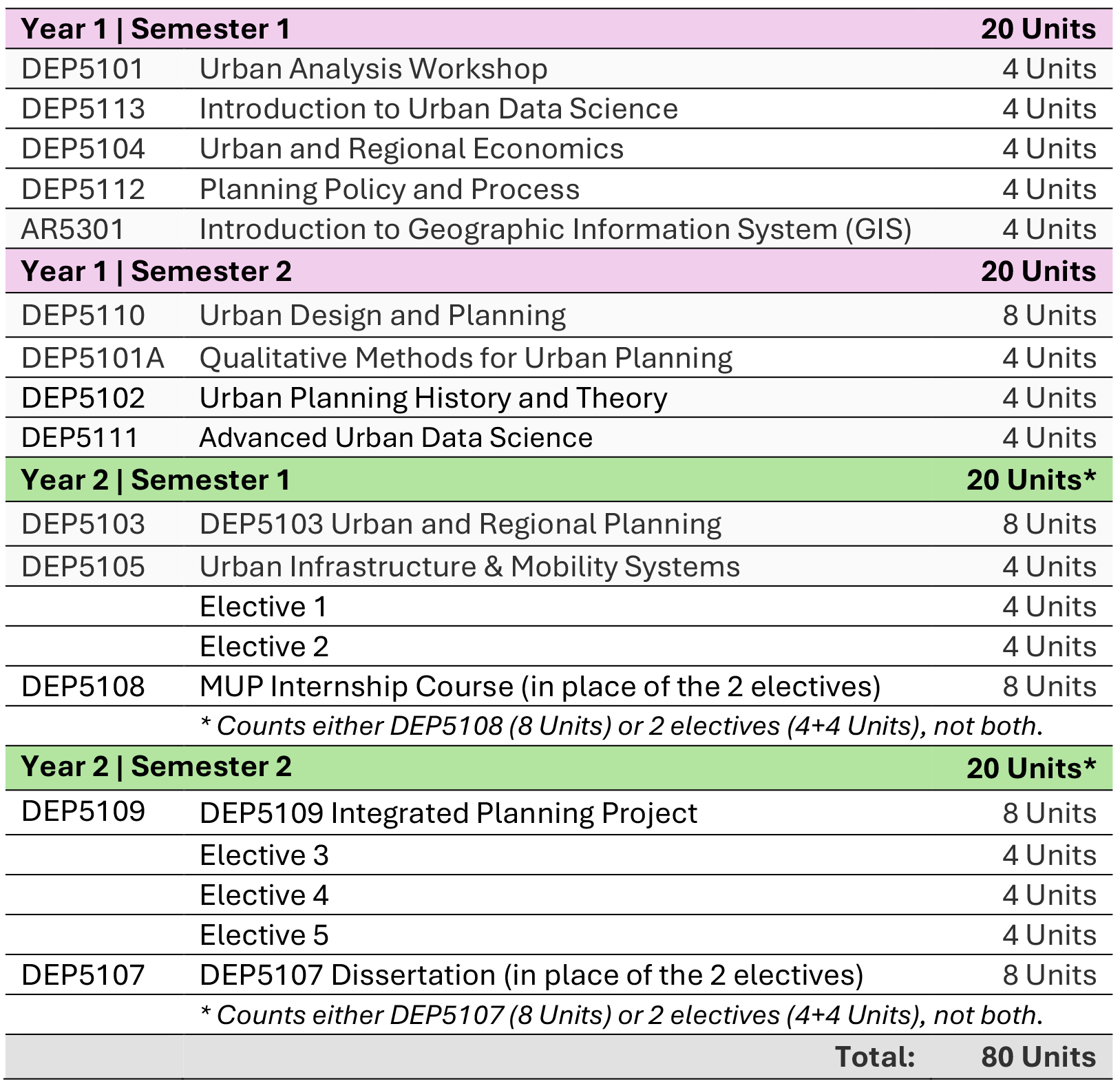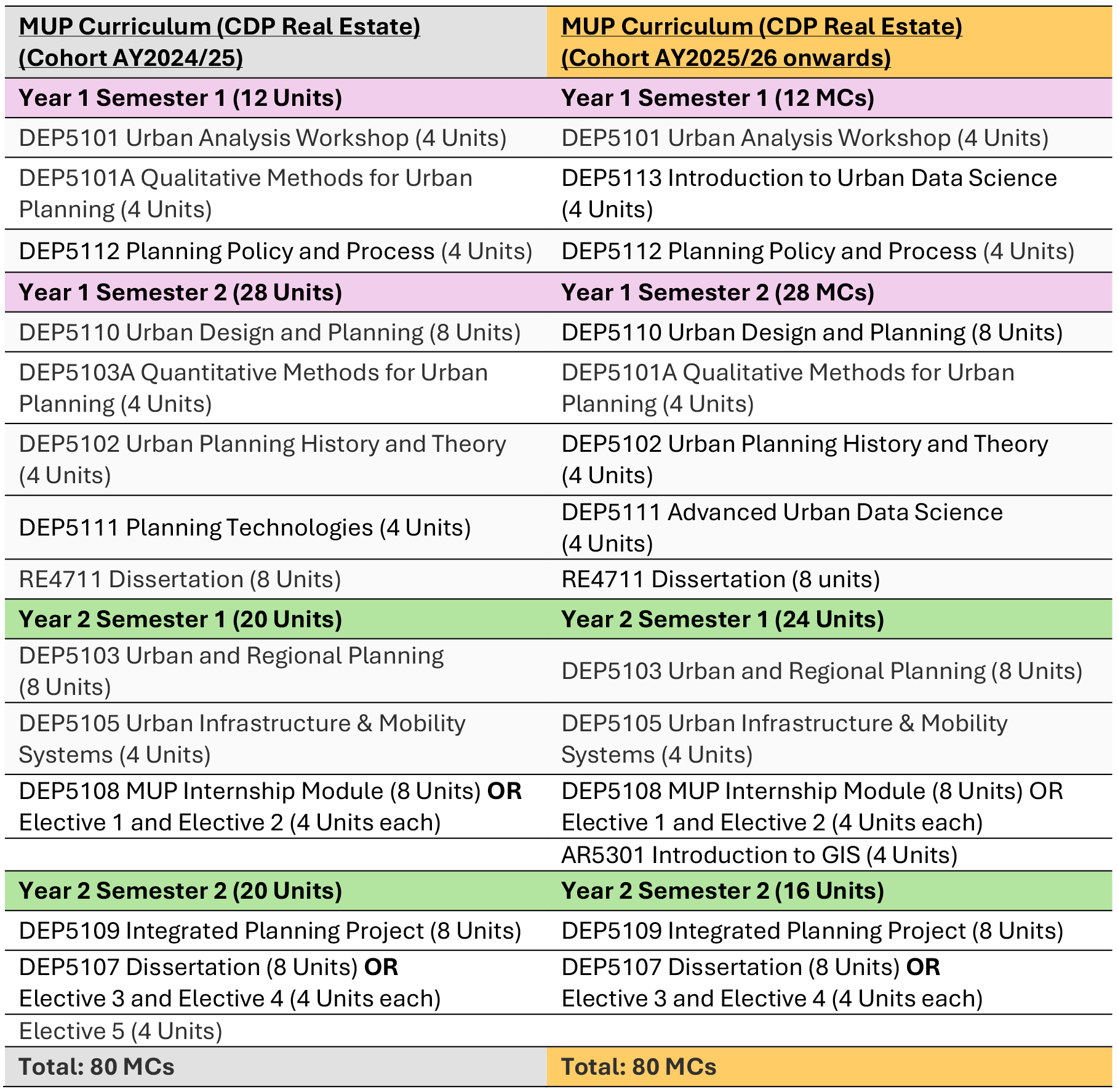Master of Urban Planning
Curriculum and Course Structure
The programme can be completed in two years (four semesters) on a full-time basis. Each semester, students should acquire 20 Units through a combination of core courses and electives.
To qualify for the Master of Urban Planning degree, a candidate must successfully complete at least 80 Units. These can be attained via a combination of 4 core studio courses (28 Units), 8 core non-studio courses (32 Units) and 5 elective courses (20 Units).
| Degree Requirements | At least 80 Units | |
| Candidature | Full-time only | minimum 2 year – maximum 3 years |
| Continuation Requirements | https://cde.nus.edu.sg/graduate/graduate-programmes-by-coursework/graduation-requirements/ | |
| Graduation Requirements | A student pursuing a Master’s degree by coursework must achieve a minimum Grade Point Average (GPA) of 3.0 to be eligible for graduation. | |
Core courses
Core courses include all planning studios as well as those that teach foundational knowledge in urban planning, such as research methods, urban data science, urban economics, history and theory. The physical planning studios occupy a central space in the core curriculum as this is where students are challenged to translate what they have learnt into spatial thinking and integrative problem-solving.
Electives
Students can select up to five elective courses from a list of graduate-level courses. This allows students to pursue their interests and find a path towards future specialisation. The list of electives may change every year depending on availability. Students can also take electives outside of the list based on their interests and future plans, subject to approval from the programme directors.
MUP YEAR 1 - FOR COHORT AY2025/26
For single track students and for students reading B.A. (Arch) concurrently (CDP)
SEMESTER 1
|
||||||||||||
SEMESTER 2
|
MUP YEAR 2 – FOR COHORT AY2025/26
For single track students and for students reading B.A. (Arch) concurrently (CDP)
SEMESTER 1
|
||||||||||||
| * Counts either DEP5108 (8 Units) or 2 electives (4+4 Units), not both.
SEMESTER 2
|
* Counts either DEP5107 (8 Units) or 2 electives (4+4 Units), not both.
FOR COHORT AY2024/25
FOR COHORT AY2026/27 ONWARDS
FOR CDP: BSc (Real Estate)
Internship
The internship course (DEP5108) can be taken by students during the long vacation between Years 1 and 2. It gives students the opportunity to experience professional life in Singapore as well as complement what has been taught in class. It may also open up opportunities for future formal employment.
Since 2020, internships may be conducted with overseas companies/organisations. The internship lasts for a minimum period of two months and is conducted on a full-time basis (40 hours/week). It takes the place of two electives.
Students who wish to undertake this course should fulfil the following conditions:
1. Completed and passed Year 1 of the MUP.
2. The internship will take place for a minimum period of two months during the long vacation between Semester 2 and 3, and take up five full working days (about 40 hours) per week.
3. The student should submit the “Application for Internship Course (DEP 5108)” at least two weeks before the proposed start of the Internship.
4. The student is required to make two oral presentations to the supervisor during the period of the internship as well as submit a final report.
Companies and government agencies that have accepted interns from the MUP include:
Surbana
Cistri
AEDAS
Housing Development Board
Centre for Liveable Cities
WATG
The details of how to source and apply for an internship are available here, and the “Application for Internship Course” form is here.
OVERSEAS FIELDTRIP
The overseas fieldtrip is usually conducted during the recess week of the last semester of MUP programme (Semester 2 of Year 2) or during the vacation period between the first and the second semesters of Year 2. The fieldtrip supports the DEP5109 Integrated Planning Project, which is the final studio of the programme. Different option studios would travel to different cities in the region for four to six days, whereby the aims of the trip may include: conducting site visits and data collection, visiting case study projects, collaborating with overseas academic institutions, planning authorities, and/or planning companies, learning about how urban planning is carried in a different context, exploring the city to appreciate its physical structure and urban life, etc.
Preparation for the MUP programme
Every MUP cohort is a diverse group with backgrounds in architecture, urban planning, landscape architecture, land management, real estate, geography, engineering and the liberal arts, to name a few. To ensure that students are able to participate fully in the planning studios, we recommend that students preparing to enter the programme familiarize themselves with some of the common visualization and computer-aided drawing software used in studio-work, including AutoCAD, 3D modelling software, Adobe Photoshop, etc. QGIS will be taught as part of the curriculum.
The list of software and how to access them online is here.
GRADUATION REQUIREMENTS
The graduation requirement is 80 Units and with a Grade Point Average (GPA) of at least 3.00. The 80 Units are attained by completing the following:
4 Essential Courses (Studio Projects) comprising 28 Units;
8 Essential Courses (Non-Studio) comprising 32 Units;
5 Elective Courses, selected from the multidisciplinary basket of approved courses, comprising 20 Units.
The MUP programme is designed to be completed in four semesters (two years) on a full-time basis. Full-time candidates must complete the requirements of the programme within a maximum candidature period of six semesters (three years).


